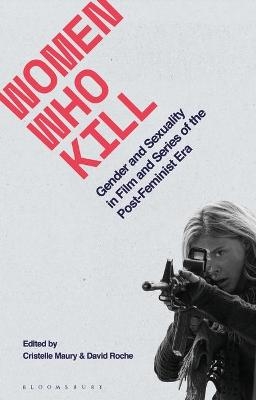
Women Who Kill
Bloomsbury Academic (Verlag)
978-1-350-11559-0 (ISBN)
The book is structured in three parts: Neo-femmes Fatales; Action Babes and Monstrous Women. Films and series examined include White Men Are Cracking Up (1994); Hit & Miss (2012); Gone Girl (2014); Terminator (1984); The Walking Dead (2010); Mad Max: Fury Road (2015); Contagion (2011) and Ex Machina (2015) among others.
David Roche is Professor of Film Studies at Université Paul Valéry Montpellier 3, France and President of SERCIA. He is the author of Quentin Tarantino: Poetics and Politics of Cinematic Metafiction (2018) and Making and Remaking Horror in the 1970s and 2000s (2014), and has edited several books, including Comics and Adaptation (2018, with Benoît Mitaine and Isabelle Schmitt-Pitiot), Steven Spielberg, Hollywood Humanist & Wunderkind (2018) and Intimacy in Cinema (2014, with Isabelle Schmitt-Pitiot). Cristelle Maury is Associate Professor at Université Toulouse Jean Jaurès, France. She has published many articles on classical film noir and on the relationships between feminist film criticism and films. She has co-edited three issues of Miranda, on new forms of adaptations, on circulations and transfers in film, and on mapping gender.
Series Editor's Introduction, Angela Smith and Claire Nally
Introduction, Cristelle Maury and David Roche
Part I Neo-Femmes Fatales
Chapter 1 The Femme Fatale of the 1990s Erotic Thriller: A Post-feminist Killer?, Delphine Letort
Chapter 2 The African Femme Fatale: Re-Appropriation of a Mythical Figure in White Men Are Cracking Up (Ngozi Onwurah, 1994), Emilie Herbert
Chapter 3 Transwoman Who Kills: Hit & Miss (Sky Atlantic, 2012), Isabelle Schmitt-Pitiot
Chapter 4 Genre and Gender in Sin City: A Dame to Kill For (Frank Miller and Robert Rodriguez, 2014), Christophe Gelly
Chapter 5 Textbook Femme Fatale, De-eroticised Neo-noir Heroine or Post-Feminist Woman Who Kills? Genre Trouble in Gone Girl (David Fincher, 2014), Cristelle Maury
Part II Action Babes
Chapter 6 From Sarah Connor 2.0 to Sarah Connor 3.0: Women Who Kill in the Terminator Franchise, Marianne Kac-Vergne
Chapter 7 Girls against Women: Contrasting Female Violence in Contemporary Young Adult Dystopias, Adrienne Boutang
Chapter 8 Motherhood, Domesticity and Nurturing in the Post-Apocalyptic World: Negotiating Femininity in The Walking Dead (AMC, 2010-), Marta Suarez
Chapter 9 An Audience Studies Approach to Tarantino’s Violent Heroines in Kill Bill (2003-2004) and Death Proof (2007), Connor Winterton
Chapter 10 Licensed to Kill? Arming and Disarming Female Killers in Action Film and Parody in Mad Max: Fury Road (George Miller, 2015) and Spy (Paul Feig, 2015), Elizabeth Mullen
Part III Monstrous Women
Chapter 11 The Women Who Killed Too Many: Contagion (Steven Soderbergh, 2011) and Female Virality, Julia Echeverría
Chapter 12 Black Female Empowerment, Intersectionality and the Ganja character in Da Sweet Blood of Jesus (Spike Lee, 2014), Hélène Charlery
Chapter 13 Monstrous Feminists? Witches, Murder, and Avatars of (Post-)feminism in American Horror Story: Coven (FX, 2013-2014), Mikaël Toulza
Chapter 14 Furies and Female Empowerment: The Sword and the Pen in Byzantium (Neil Jordan, 2012) and Crimson Peak (Guillermo del Toro, 2015), Carolina Abello Onofre and Christophe Chambost
Chapter 15 Masculine Cultures of Technology and the Robotic Female Avenger in Ex Machina (Alex Garland, 2015), Samantha Lindop
Chapter 16 “You’re a Dangerous Girl”: Beauty and Violence in The Neon Demon (Nicolas Winding Refn, 2016), Janice Loreck
Chapter 17 Evidence of Cruel Optimism - Nick Broomfield’s Aileen: Life and Death of a Serial Killer (2003), Rosie White
Afterword Women Who Kill after #MeToo, David Roche and Cristelle Maury
Contributors
Index
| Erscheinungsdatum | 21.02.2020 |
|---|---|
| Reihe/Serie | Library of Gender and Popular Culture |
| Zusatzinfo | 36 b/w illus |
| Verlagsort | London |
| Sprache | englisch |
| Maße | 138 x 216 mm |
| Gewicht | 574 g |
| Themenwelt | Kunst / Musik / Theater ► Film / TV |
| Sozialwissenschaften ► Kommunikation / Medien ► Medienwissenschaft | |
| Sozialwissenschaften ► Soziologie ► Gender Studies | |
| ISBN-10 | 1-350-11559-2 / 1350115592 |
| ISBN-13 | 978-1-350-11559-0 / 9781350115590 |
| Zustand | Neuware |
| Informationen gemäß Produktsicherheitsverordnung (GPSR) | |
| Haben Sie eine Frage zum Produkt? |
aus dem Bereich


